How to Install a Printer?
Printers have become an indispensable tool in both home and office environments. They are essential for producing hard copies of documents, photographs, and other important materials. Whether it’s for professional reports, academic assignments, or personal projects, a reliable printer is a must-have in today’s digital age.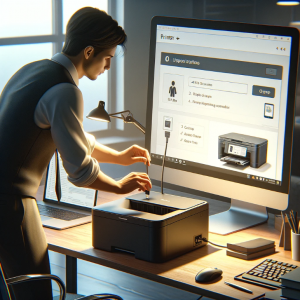
Understanding how to properly install a printer is important to ensure its optimal functionality and to avoid any unnecessary frustrations. That’s why we’ve created this comprehensive printer installation guide. Our aim is to provide you with a clear, step-by-step guide on how to install a printer, covering various types and connection methods. Whether you’re setting up your first printer or looking to upgrade your existing configuration, this guide is designed to help you seamlessly integrate your printer into your workspace. So, let’s dive into the world of printers and make your printing experience as smooth as possible.
Preparation Before Installation
Before you embark on the journey to install a printer setup, it’s crucial to ensure that your printer is compatible with your computer or network. Below are the steps for the same:
-
Check Printer Compatibility:
Verify that the printer is compatible with your computer or network by comparing the printer’s specifications with your system’s requirements.
-
Gather Necessary Cables:
Collect all required cables, including power and connectivity cables (USB or Ethernet), to ensure your printer can connect to your computer or network.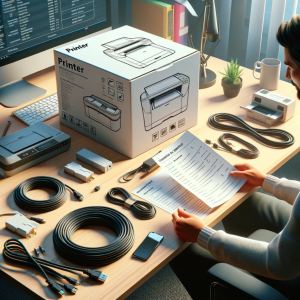
-
Ensure a Stable Power Source:
Confirm that the power outlet you plan to use is reliable and provides consistent power supply. A stable power source is essential for the successful operation of your printer.
-
Download Latest Printer Drivers:
Visit the manufacturer’s website, find the support or downloads section, and download the most recent drivers for printer model and operating system. Installing correct printer driver is crucial for optimal printer performance and functionality.
These procedures will help to guarantee a seamless and successful setup process for your printer, laying a solid foundation for its installation and operation.
Types of Connections to Install a Printer
When it comes to setting up your printer, understanding the different types of printer connections is crucial. Depending on your needs and the capabilities of your printer, you can choose from USB, wireless, or network connections. Each connection type has its own set of steps for installation.
-
USB Connection:
The most straightforward way to connect a printer is via a USB cable. To install a printer using a USB connection, follow the steps:
-
- Link the printer to one end of the USB cord and your computer to the other.
- The printer should be recognized by your computer automatically, and ask you to install the necessary drivers.
- Follow the on-screen assistance to complete the installation process.
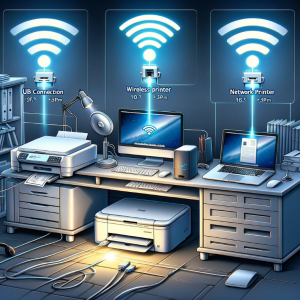
-
Wireless Connection:
If you prefer a clutter-free setup, you might opt for a wireless printer installation. The steps to install a wireless printer are:
-
- Ensure both your printer and computer are connected to the same WiFi connection.
- Use the printer’s control panel to navigate to wireless setup options and connect to your network.
- Add the printer to your computer through the ‘Devices and Printers’ or ‘Printers & Scanners’ settings.
-
Network Printer Installation & Setup:
For office environments or shared spaces, a network printer installation might be the best option. This setup allows many users to access the same printer over a local network. To install a network printer:
-
- Suitable for office environments or shared spaces, allowing multiple users to access the same printer over a local network.
- Obtain the printer’s IP address from its network settings.
- Access the ‘Devices and Printers’ section on your computer and add printer using its TCP/IP address or hostname.
- Follow the assistance to complete the installation.
By understanding these different types of printer connections and following the appropriate steps, you can install your printer in a way that best suits your needs and environment. Whether you choose a USB, wireless, or network connection, ensure that you have the necessary drivers installed for a smooth and efficient printing experience.
Printer Driver Installation
Printer drivers are essential software components that enable your computer to communicate with your printer. They convert the information from your PC into a format that the printer can read, making sure that your printouts look exactly as intended. Proper printer driver installation is crucial for the smooth operation of your printer and to access all its features.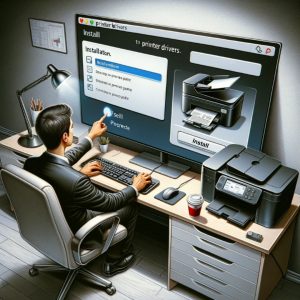
-
Step-by-Step Guide to Installing Printer Drivers
-
Windows 10:
- Go to ‘Settings’ > ‘Devices’ > ‘Printers & scanners’.
- After selecting “Add a printer or scanner,” watch for your printer to appear in the list.
- Click ‘Add’ after choosing your printer from the list. Windows will automatically install printer driver.
- If your printer is not listed, you may need to download the driver from manufacturer’s website and install it manually.
-
MacOS:
- Click ‘Printers & Scanners’ after opening ‘System Preferences’.
- Add a new printer by clicking the ‘+’ button.
- Select your printer from the list and click ‘Add’. macOS will typically install printer driver
- If the driver is not installed by itself, download it from the manufacturer’s website and follow the installation instructions.
-
Linux:
- Open the ‘Printers’ application from the system settings.
- Click ‘Add’ and choose your printer from the list.
- Follow the instructions to install printer driver. You may need to select the appropriate driver from a list or provide a PPD file.
- If your printer is not listed, you may need to install printer driver manually by downloading it from the manufacturer’s website or using a package manager.
-
-
Troubleshooting Tips if the Driver Installation fails
-
Driver Not Found:
If your operating system cannot find the appropriate driver, visit the manufacturer’s website to download the latest version.
-
Installation Errors:
Make sure you have administrative rights to install drivers. Disable any antivirus software temporarily, as it can sometimes interfere with the installation process.
-
Compatibility Issues:
Verify that the driver you are installing is suitable with your operating system version.
-
Printer Not Responding:
If the printer is not working after driver installation, try restarting both your computer and the printer.
-
Printer Offline:
If the offline status is displayed on your printer, check whether the WiFi network is properly connected or not. To know more about this issue, read our comprehensive blog on Printer Offline issue.
-
By following these steps and tips, you can ensure a successful printer driver installation on various operating systems, allowing your printer to function correctly and efficiently.
Configuring Printer Settings after Driver Installation
Once you have successfully installed your printer and its drivers, the next step is to configure the printer settings to fit your specific needs. Accessing and adjusting these settings ensures that your documents are printed with desired quality and format.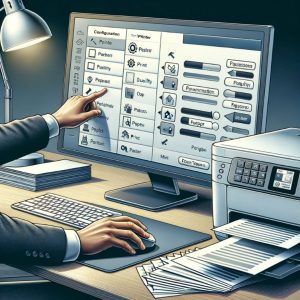
-
Accessing Printer Settings
-
Through Control Panel (Windows):
- Open the Control Panel and navigate to ‘Hardware and Sound’ > ‘Devices and Printers’.
- Right-click on your printer icon and select ‘Printing Preferences’ to access the settings.
-
Through Printer Software:
- Most printers come with dedicated software that allows you to manage settings directly.
- Open the printer software from your computer’s application menu and navigate to the settings.
-
-
Adjusting Printer Settings
-
Print Quality:
-
Modify the print quality settings to balance between speed and clarity. Higher quality settings are ideal for important documents or photos, while lower settings can save ink for draft prints.
-
-
Paper Size and Type:
-
Choose the right kind and size of paper depending on the document you are printing. Common sizes include A4, Letter, and Legal.
-
-
Orientation:
-
Select between portrait or landscape orientation depending on the layout of your document.
-
Setting the Printer as the Default
If you use multiple printers, you may want to set your frequently used printer as the default to streamline the printing process.
-
-
Windows:
Navigate to ‘Control Panel’ > ‘Devices and Printers’. Choose “Set as default printer” when you do a right-click on your printer.
-
-
-
MacOS:
Open ‘System Preferences’ > ‘Printers & Scanners’. Click on your printer in the list and click ‘Set as Default’.
-
-
Additional Tips
-
Install Printer for All Users (Windows):
-
If you want the printer to be available to all users on a Windows computer, you can install printer for all users by selecting the appropriate option during the installation process.
-
-
Install Microsoft Print to PDF:
-
This feature allows you to save documents as PDF files. You can install or reinstall Microsoft Print to PDF through the ‘Turn Windows features on or off’ option in the Control Panel.
By properly configuring your printer settings, you can make sure that your prints meet your expectations in terms of quality, size, and orientation. Regularly review and adjust these settings as required to maintain optimal printing performance.
Printing a Test Page
Printing a test page is a crucial phase in ensuring that your printer is operating correctly after installation or when troubleshooting issues. It helps you verify the printer’s connectivity, print quality, and alignment. Here are the instructions on how to print a test page and interpret the results: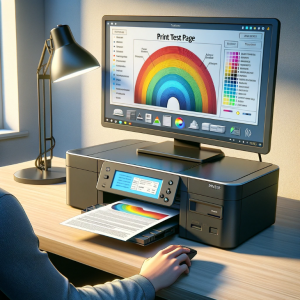
-
How to Print a Test Page
-
Windows:
- Go to ‘Control Panel’ > ‘Devices and Printers’.
- Right-click on printer icon and select ‘Printer Properties’.
- Click on ‘General’ tab, then click ‘Print Test Page’.
-
-
-
MacOS:
-
-
-
- Open ‘System Preferences’ > ‘Printers & Scanners’.
- Select your printer from list and click ‘Open Print Queue’.
- Select ‘Printer’ from the menu bar and then select ‘Print Test Page’.
-
-
-
Linux:
-
-
-
- Open the ‘Printers’ application from the system settings.
- Right-click on your printer and select ‘Properties’.
- Find option to print a test page, which may vary depending on the distribution.
-
-
Interpreting Test Page Results
-
Print Quality:
Check for clear and sharp text and graphics. Look for any smudges, streaks, or faded areas.
-
Color Accuracy:
If your printer is color-capable, ensure that the colors on the test page match the expected results.
-
Alignment:
Verify that the text and graphics are properly aligned and not skewed.
-
Connectivity:
If the test page prints successfully, it indicates that the printer is correctly connected to your computer.
-
-
Troubleshooting Common Issues
-
Poor Print Quality:
Clean the print heads or nozzles and check for low ink or toner levels.
-
Misalignment:
Perform an alignment procedure using your printer’s software or control panel.
-
No Printout:
Ensure that the printer is turned on, properly connected, and has paper loaded. Check for any error messages and resolve them accordingly.
-
-
Additional Tips
-
Mobility Print Installer:
If you’re using a mobile device or a Chromebook, consider using a mobility print installer to easily connect and print from your device.
-
Reinstall Printer:
If you continue to encounter issues after printing a test page, consider reinstalling the printer and its drivers to resolve any software-related problems.
-
Printing a test page is an easy and effective way to confirm that your printer is set up correctly and ready for use. Regularly performing this simple check can help you maintain your printer’s performance and troubleshoot any issues that may arise.
FAQs
Q1. How do I install a printer on my computer?
- A1. To install a printer, connect it to your computer using a USB cable or wirelessly, then follow the instructions on your computer to complete the installation process.
Q2. Where can I find the install printer driver for my new device?
- A2. You can usually find the install printer driver on the manufacturer’s website under the support or downloads section for your specific printer model.
Q3. What should I do if I need to uninstall printer driver from my system?
- A3. To uninstall printer driver, go to your computer’s ‘Control Panel,’ select ‘Devices and Printers,’ right-click on your printer, and choose ‘Remove device’ or ‘Uninstall.’
Q4. Can you guide me on how to install wireless printer in my home network?
- A4. To install wireless printer, ensure your printer is powered on and attached to the same Wi-Fi network as your computer. Then, use the ‘Add a printer’ wizard in your computer’s settings to detect and install the printer.
Q5. What are the steps to reinstall printer driver if it’s not working properly?
- A5. To reinstall printer driver, first uninstall the existing driver from your computer, then download the most recent driver from the manufacturer’s website and follow the installation instructions.
Q6. How do I install printer on MacBook for the first time?
- A6. To install printer on MacBook, connect the printer to your MacBook or connect both to the same Wi-Fi network. Then, open ‘System Preferences,’ click on ‘Printers & Scanners,’ and add your printer.
Q7. What is the process to install network printer Windows 10 in an office setting?
- A7. To install network printer Windows 10, go to ‘Settings,’ then ‘Devices,’ and select ‘Printers & Scanners.’ Choose ‘Add a printer or scanner’ and select your network printer from the list.
Q8. Is it easy to install new printer by myself, or should I seek professional help?
- A8. You can usually install new printer by yourself by following the manufacturer’s instructions. However, if you encounter any difficulties, it may be helpful to seek professional assistance.
Q9. How can I install Microsoft Print to PDF as a printer option on my computer?
- A9. To install Microsoft Print to PDF, go to ‘Control Panel,’ select ‘Programs and Features,’ click ‘Turn Windows features on or off,’ and choose the box for ‘Microsoft Print to PDF.’
Q10. What should I do to uninstall printer that is no longer needed?
- A10. To uninstall printer, go to ‘Control Panel,’ Choose ‘Devices and Printers,’ then do a right-click on the printer you want to remove, and choose ‘Remove device’ or ‘Uninstall.’
Conclusion
In this blog, we’ve explored the crucial steps and tips for successful printer installation and maintenance. We started by emphasizing the importance of checking suitability and gathering the necessary cables before installation. We then discussed the different types of printer connections, including USB, wireless, and network options, and provided guidance on installing the latest printer drivers for various operating systems. Additionally, we covered how to configure printer settings for optimal print quality, paper size, and orientation. Regular maintenance and troubleshooting were also highlighted as important factors in ensuring the longevity and optimal performance of your printer.
If you’re planning to install a new printer or looking to enhance your current setup, following the guidelines outlined in this blog will help you achieve the best results. We encourage you to reach out to printer support for any further assistance or if you encounter any challenges. Whether you want to install new printer or maintain an existing one, having the right support can make a significant difference to make sure a smooth and efficient printing experience.
To know more about Printer Support Service, visit our Homepage.
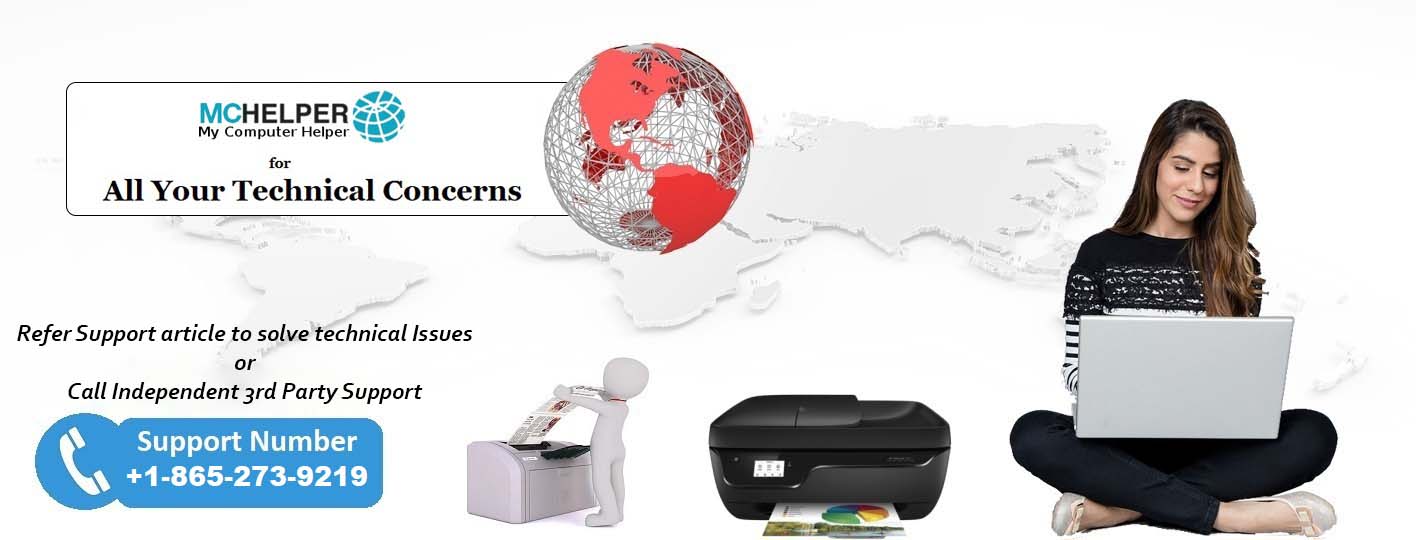
Steven perez
I’m attempting to install a new printer in my home office, and I’ve heard that the initial setup is crucial for its performance. Can you provide a detailed guide on the most efficient way to install printer setup and ensure it operates smoothly with my existing devices?
Support Admin
Absolutely, setting up your new printer correctly from the start is essential for its performance and integration with your devices. First, ensure your printer is compatible with your computer or network by checking the printer’s specifications against your system’s requirements. If you’re connecting via USB, gather the necessary cable. For a wireless connection, ensure your Wi-Fi network is stable.
Elizabeth wilson
I’ve recently switched to a MacBook and need to install printer on Mac. What are the steps involved in adding a printer to my MacBook, especially if it’s a wireless printer?
Support Admin
Installing a printer on your MacBook, particularly a wireless one, is a straightforward process. First, ensure that both your printer and MacBook are connected to the same Wi-Fi network. Next, on your MacBook, go to ‘System Preferences’ > ‘Printers & Scanners’. Click the ‘+’ button to add a new printer. Your MacBook should automatically detect printers on the network. Select your printer from the list and click ‘Add’. MacOS typically installs any necessary drivers automatically. If your printer is not immediately recognized, you might need to download and install printer driver manually from the manufacturer’s website. This process enables you to install wireless printer on your MacBook efficiently.